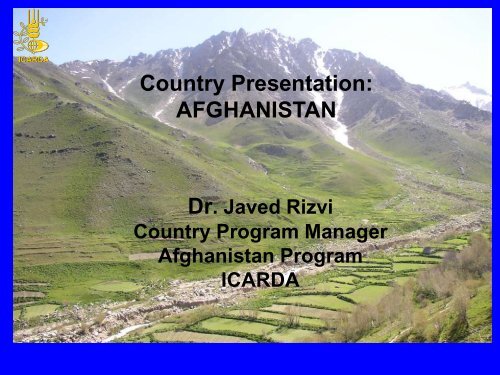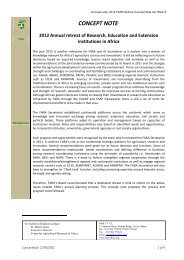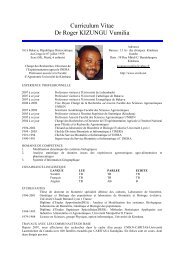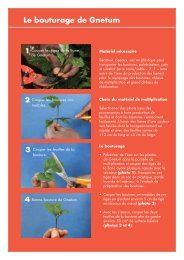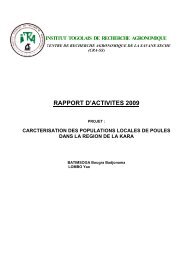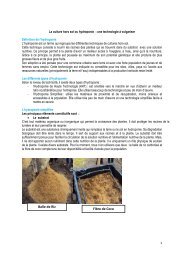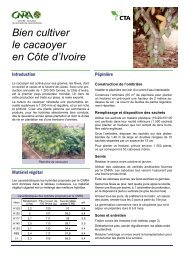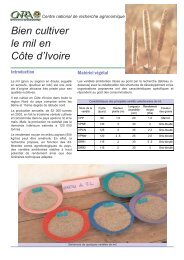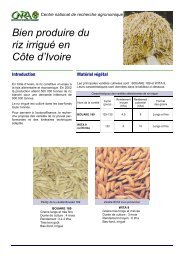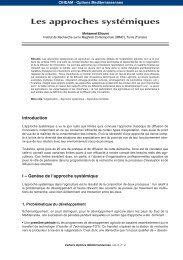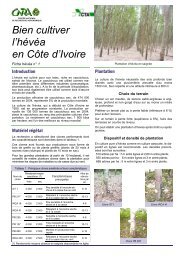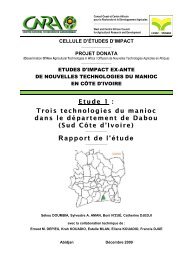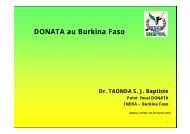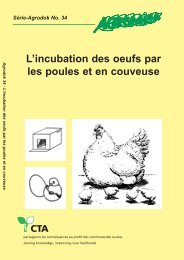Country Presentation: AFGHANISTAN - eRails
Country Presentation: AFGHANISTAN - eRails
Country Presentation: AFGHANISTAN - eRails
- No tags were found...
You also want an ePaper? Increase the reach of your titles
YUMPU automatically turns print PDFs into web optimized ePapers that Google loves.
杨 伟 斌 滕 坚 深 圳 职 业 技 术 学 院 物 理 实 验 室 广 东 深 圳 分 别 介 绍 高 频 低 频 光 栅 的 制 作 原 理 和 制 作 实 例 并 对 制 作 光 栅 的 质 量 进 行 评 定 高 频 光 栅 低 频 光 栅 光 栅 制 作 光 栅 质 量 评 定
<strong>AFGHANISTAN</strong>Background Information:• Population = 27 million• 78 % Population lives in rural areas• 80 % Population involved in agriculture• 51 % GDP from Agriculture• 12 % (7.8 millions) of 65 millions is arable land• Significant reduction in irrigated land as of 1970• 1.7 million ha rainfed agriculture• 4.3 millions under intermittent/ temporary cultivation• 30 millions pastures
<strong>AFGHANISTAN</strong>TIMELINE of CONFLICT• 1919: Gained independence from Britain, although itwas never officially part of the British Empire• 1926: Kingship ends• 1953: Government changes• 1964: Monarchy established• 1973: Monarchy overthrown - socialist governmentsupported by USSR• 1978: Mujahedeen movement established - armedrevolt
<strong>AFGHANISTAN</strong>TIMELINE of CONFLICT• 1979: Soviet intervention• 1985: After seven years of war nearly half of thepopulation became refugees• 1989: Soviet troops leave, war continues• 1992: The government falls, The country descends intocivil war• 1994: Taliban, became strong political and religious force• 1996: Taliban takes control
TIMELINE of CONFLICT<strong>AFGHANISTAN</strong>• 2001 (December): Entry of International forces (ISAF)• 2004 (March): 4.5 billion pounds pledged by variousdonors• 2006 (February): International donors pledged morethan 5.7 billions pounds• ISAF so far lost about 4000 of its members, andthousands of civilians are killed, millions displacedinternally and externally
AfghanistanVOILENCE and CONFLICT continues• A battle ground for strategic war by larger externalpowers• Fragmented & polarized nature of the society madeup of several ethnic groups• Multiple internal struggles supported by externalpower
<strong>AFGHANISTAN</strong>• Besides conflicts; prolonged droughts, unstablelivelihoods, poor capacity of the system contribute tocontinued protracted crises• Poppy cultivation and trade is another cause andconsequence of conflict• Afghanistan produces more than 90 % poppies of thetotal world production• Area under poppy cultivation increased by 7 % in 2011• Poppy production went up by 61 % (UNODC)
<strong>AFGHANISTAN</strong>Important steps taken by the Ministry of Agriculture,Irrigation and Livestock; and partners• National Agriculture Master Plan• National Research Strategy• National Seed Law• National Water Law• National Wheat Policy• Agriculture National Development Program• National Agricultural Development Framework(NADF)• Food for Life Program• Alternative Livelihoods Program (Ministry of CounterNarcotics)
Who supports Agricultural Research and Development ?• Future harvest Consortium to Rebuild Agriculture inAfghanistan – Group of 35 International Orgs. Lead byICARDA• Multi-Donor Fund- Afghanistan Reconstruction TrustFund (single largest fund of 3 billions); 40 % onagriculture and rural development)• USAID and USDA• EU – EC• Australia, Canada, Finland, France, Germany, Indian,Italy, Japan, Netherlands, New Zealand, Sweden,Switzerland,• World Bank• IFAD• Asian Development Bank
<strong>AFGHANISTAN</strong>• Agricultural Credit Enhancement Development Fund• Afghanistan Agricultural Extension Project• Irrigation and Watershed Management (Startup of2012)• Agricultural Research and Extension Development(Startup 2012)• Southern Region Agriculture Development Program(2013)• Advancing Afghan Agriculture Alliance ( $ 7 millions)• Capacity Building and Change Management Program($36 million)
<strong>AFGHANISTAN</strong>• Other Donor Funded Programs:The World Bank• National Horticulture and Livestock program (NHLP):2 phasesMulti-donor (DFID)• The Comprehensive Agriculture and RuralDevelopment Facility (CARD-F)
POOR CAPACITY of national program is the singlelargest factor prohibiting agriculture research anddevelopmentChallenges:• Exodus of educated and trained personnel asrefugees/ asylum seekers• Limited number of researchers and extension staff• Knowledge is quite old – senior staff obtained theireducation 25-30 years ago• Remained isolated for 3 decades from rest of theworld due to conflict• Process to recruit new staff is complicated, and timetaking - replenishment is very slow• Majority of newly recruited staff hold a BS degreewith no practical training
Number of research and extension workers(430 districts)35003000250020001500100050001970Agriculture ResearchInstitute ofAfghanistan (ARIA)Researchers : 75MS: 03Ph. D: 0
What is NOT working?Afghanistan• Slow recruitment process – shortage of staff – poorresource utilization• Inability to select/ nominate right candidate for righttraining• Retention and engagement of the trained staff in thespecialization trained• Short-term/ ‘refresher course’ type training• Lack of facilities and infra-structure to practice theacquired knowledge• Absence of follow up support
• What is required ?Individual –Medium and long-termInstitutional - Short, Medium, and Long termCommunity & civil service organizations – Short –Medium
AfghanistanWhat is required ?• Identification of priorities, client-driven CD• More emphasis on medium term CD (3-4 months),less on short-term• Degree level trainings• Follow ups on medium – term trainings• Linkage with funding to create enabling atmosphereto practice the knowledge acquired• CD in computer application and language skills
AfghanistanWhat is required ?• Faster recruitment of additional staff• Opportunity to deserving candidates• Preference to younger generation• Staff retention in the same field where trained• Linkages/internship/ sabbatical/ seconding staff toregional/ international organizations• Linkage to CGIAR centers
AfghanistanWhat is required ?• Better compensation package• Improved agriculture education in universities• Close linkages and coordination between agricultureeducation-research-extension• Continued training of community and farmers
IIIIIIIIIIIIIIIIIBadakhshan, Baghlan, Balkh,Bamyan, Kunduz, Takhar, Kapisa,Parwan, Kabul, Nangarhar,Laghman, Kunar, Ghazani, IHelmand, Heart, UruzganICARDA provincialOffices locationsI
Crop Improvement• Crop improvement, and best practices• Varietal testing and release, seed policies, seedsector development,• Yield gap estimation, and accelerateddissemination and adoption ofimproved varieties
New Technologies: Supplemental irrigation3.5003.0002.5002.0001.5001.0000.5000.000Yield mt/haRainfedOne irrigation
Diversification and intensification• Evaluation and introduction of off-farm livelihoods formen and women: Processing, value addition, andmarketing of medicinal plants• Diversification of wheat based cropping system• Intensification of cropping systems: Evaluation,Introduction and promotion of short duration legumesbetween two wheat crops• Research and promotion on crop-livestock system:Introduction and promotion of small ruminants (goats),feeding systems, development of local feeds, milkprocessing and value addition (1000 women)• Evaluation and Introduction of drought resistant foragecrops and perennials
Village Based Seed Enterprise: 35 established in 8 provincesIFAD will be funding additional 6 in three provincesVillage Based Seed Enterprise: Producing more than 30 % ofthe certifide seed produced in the country
Enhancing livelihoods:Goat management & feeding in Afghanistan• More than 1300 women received goats• Dairy hygiene and processing improved skills and incomes ofat least 1000 women• 3 times higher benefits by supplemental feeding of goats• 2 times benefit through improved feeding during fattening• 3 times increase in kid survival due to vaccinations• Improved growth through crossbreeding of goats
Processing & Value Addition: Medicinal Plants
Better Micro on-farm and macro water managementharvesting
Sub-surfaceirrigation
TECHNICAL BULLETINS / BROCHURES/RADIO PROGRAMS IN LOCAL LANGUAGES
CAPAPCITY DEVELOPMENT (2009-2011)(Individuals trained in Afghanistan 4731)Type oftrainingNumber ofTrainingsNumber of trained researchers,extension workers;farmersMale Female TotalIn-country 34 886 2777 3663Abroad 26 70 04 74Field days 13 974 20 994
Yield (t ha-1)% yield differenceYield Gap Reduction by AccelaratedDissimination of Improved Wheat,Rice, Mung bean and Potato Varieties25.0020.0015.0010.005.000.00Wheat Rice MungbeanPotato80.0070.0060.0050.0040.0030.0020.0010.000.00Improved Local % difference
CONCULSION• Increased agriculture productivity and productionleading to food and nutritional security; andemployment and income generation ensuring accessto food is the key to bring the stability and peace inProtracted Crises Countries• Capacity Development is the most effective tool toachieve the above goals• Increased coordination between all the actors(national, regional and international)• Pre-emptive/ proactive action to avoid conflict andcrisis, NOT a reaction to crisis


